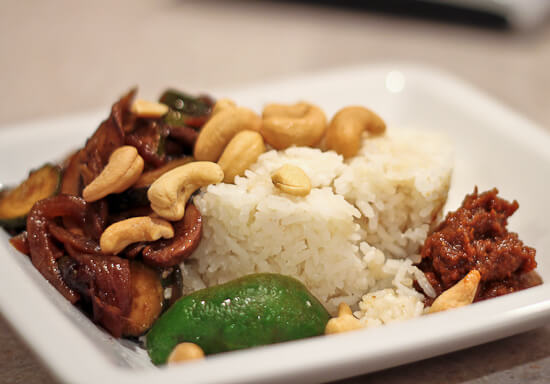
Happy Thanksgiving!
I know everyone is featuring fantastic things to do with leftover turkey right about now. But… I hate turkey. I personally think we have been brainwashed as a nation to think that the driest, most boring meat imaginable should be the centerpiece of our most food-oriented holiday feast. But I won’t go on and on, I get that many of you love it.
Which is why I am featuring this super awesome condiment that I promise you would go just fine with your turkey leftovers. Just chop them up and add them to any of these dishes–or any different ones you come up with.
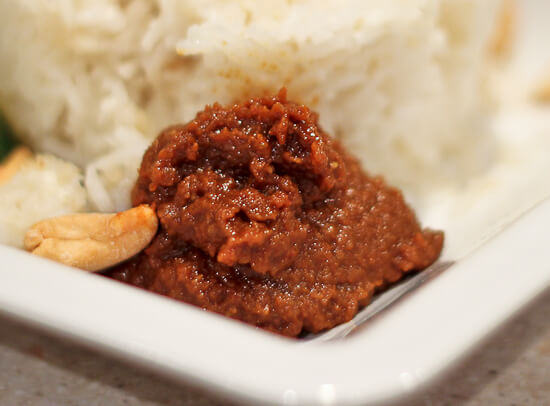
I’ll give you some advice about how to assemble the dish, but first a little about the condiment itself: As per James Oseland, who writes about sambals in his incredibly read-able Cradle of Flavor: Home Cooking from the Spice Islands of Indonesia, Singapore, and Malaysia, a sambal, derived from the Indian word sambhar (a fiery hot dal), is a chile pepper-based condiment providing extra heat and flavor in Indonesia, Malaysia and Singapore. They can be seriously fiery hot, usually when raw, as in the case of the commercial sambal olek that I reach for when I need fresh, raw heat in a dish. But sambal olek, at least the commercial version, does not have much subtlety–it is just pure unadulterated chile pepper heat. There are many other sambals, also raw and fiery hot, that provide other layers of flavor. However, for my purposes, the attraction of this sambal is that it is cooked, which mellows out that heat.
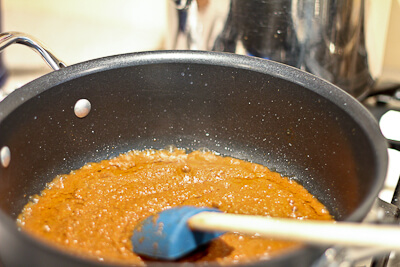 You can see in this picture the color that the sambal starts out…
You can see in this picture the color that the sambal starts out…
You should know that I did not follow any strictly Indonesian or otherwise recipe. As a result, my sambal ended up heavily influenced by my own tastes, which were in turn influenced by my love and familiarity with Thai cuisine. For example, I could not resist throwing in some dried peppers as well, especially because the flavor selection of dried peppers is better than fresh in the Midwest, especially in November. For the same reason, I used green fresh chile peppers–it is impossible to find red ones that are not sweet or tiny and fiery hot. Along these same lines, I was aiming for really flavorful chile peppers, but not hot ones. Otherwise, only John and I could have eaten it (and honestly even I would have problems with too much heat after cooking for my kids for this long).
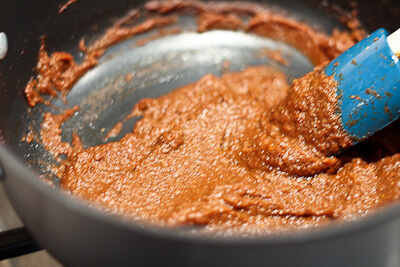 And here you can see how the sambal has thickened and darkened with cooking.
And here you can see how the sambal has thickened and darkened with cooking.
The beauty of any sambal is that you can take a relatively bland dish, like sauteed veggies, rice, and, ahem, turkey, and just add a tablespoon or 2 of sambal and you have an entirely different dish. I used this sambal in 3 different dishes: first I sauteed onions, mushrooms and zucchini and served them with a fried egg (the runny yolk is delicious with the sambal) and raw spinach (pictured last, at the bottom–our least favorite as the spinach overpowered it a bit). The next night I served the leftover sauteed veggies with cashews and a fried egg, which was incredibly yummy (pictured above, only I forgot the fried egg at first). The cashews are also a great complement to the sambal. Then, I threw the sambal in an airtight container, where it stayed for about a week, at which point I sauteed onions, sweet bell pepper and Napa cabbage and served it with rice, cashews, and a fried egg (pictured right below). Another big hit–and an incredibly easy weeknight dinner. From these example, you can see how easy it would be to throw in chopped leftover turkey.
One note: with all three dishes I admit I also threw in some fish sauce (not traditionally used in Indonesia, Malaysia or Singapore) and lime juice.
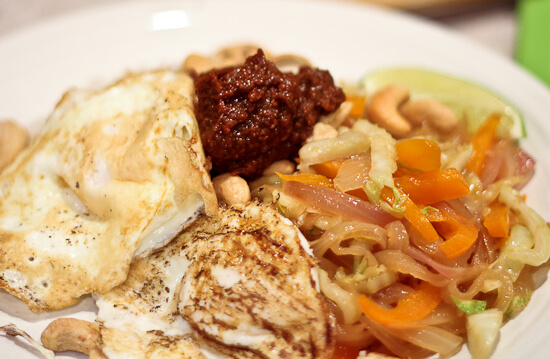
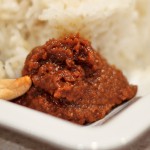
- 1 medium onion
- 5 dried california chile peppers,, soaked in boiling water for 20 minutes, soaking water reserved
- 4 green anaheim chile peppers, prefer red, chopped (and seeded if you want to avoid too much heat)
- 1 T shrimp paste, I used Thai because that is all I have; by all means use Indonesian or Malaysian if you can find it
- 1 T tamarind concentrate
- 6-8 cloves garlic
- 1 T toasted coriander seeds
- 1 t toasted white peppercorns
- 2 t toasted cumin seeds
- 1 T brown sugar
- 1/4 t salt
- 1/4 cup vegetable oil, peanut is preferred
-
If you have a wet-dry grinder or a Vita-Mix, then place all of the ingredients except the oil into the grinder and blitz, using the chile pepper soaking water as necessary to loosen the paste. However, if you do not, you will need to grind the spices separately in a spice grinder and then add everything to a processor or blender. Either way, puree until fine (because of the dried chile peppers, you will want this very well well pureed--some would even suggest pushing it through a mesh strainer, but I am not so bothered by pieces of chile pepper and honestly now that I have the wet dry grinder it is not an issue anyway).
-
Heat the oil in a large heavy skillet, such as cast iron. When it shimmers, add the paste. It should sizzle gently, not violently. Cook, stirring occasionally, for 10-15 minutes. At this point taste for salt or additional cooking if it still tastes too raw. You might want to use a cracker or some rice, as its flavor is quite strong. If it looks like it is drying out, add some water.
-
Keep the sambal in an airtight container in the refrigerator. Oseland says 1 week; I would think you could keep it a tad longer, but not much as its strong flavor could mask mold or germs.
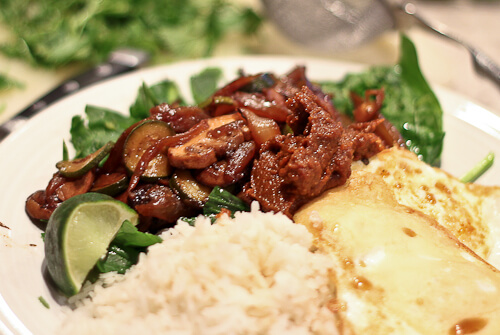
You take after your grandfather. He wasn’t a fan of turkey, either. Grandma always made chicken or some sort of pasta on T-Day. I don’t ever remember having turkey until I was in college (and they started having T-Day at your house with your mom cooking.) He was, however, a big fan of the the sweet potatoes and the rolls.
By the way, I plan on making that mint chocolate cake that Sammy had. Sounds yummy.
Mmm, that looks so flavorful! I love your sambal base, and the cashews must make this shine 🙂